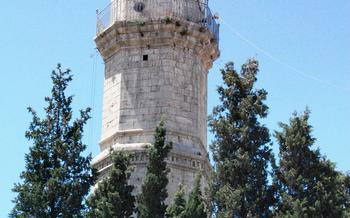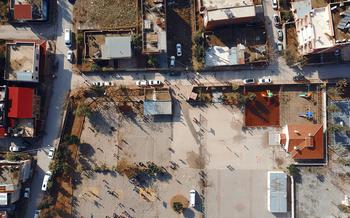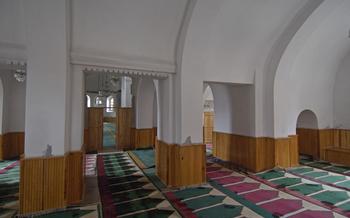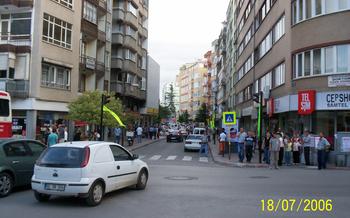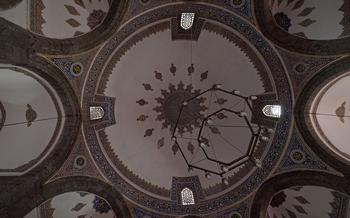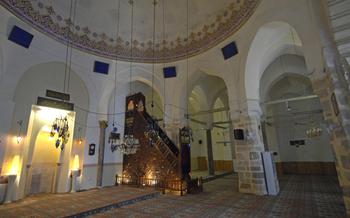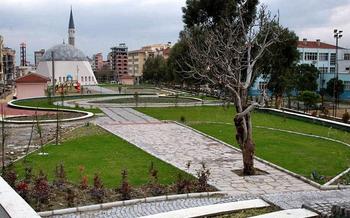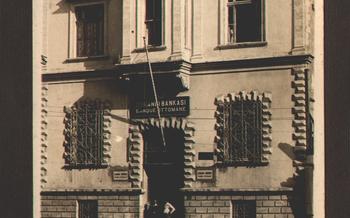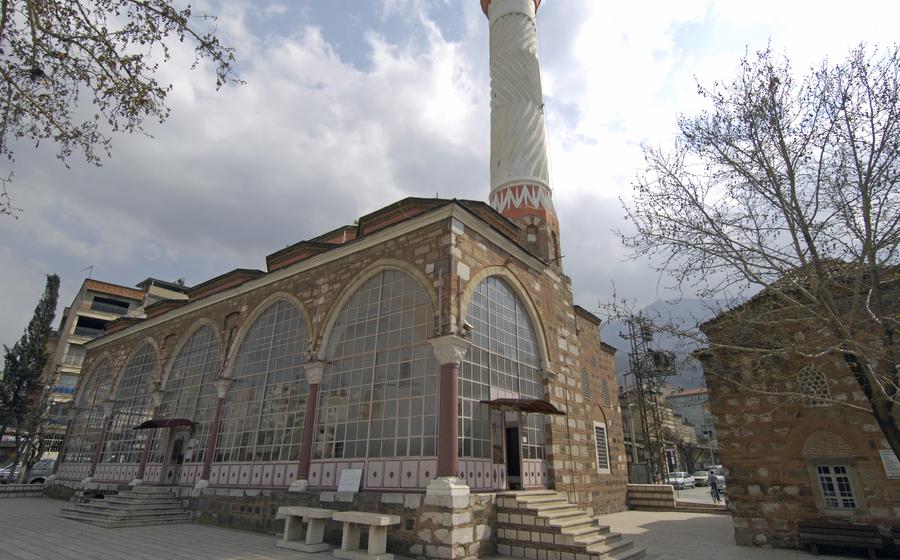
Hatuniye Mosque
- Historical Significance
- Architectural Masterpiece
- Religious Importance
- Interior Exploration
- Historical Context
- Local Traditions
- Architecture and Symbolism
- Local Crafts and Handicrafts
- Religious Ceremonies and Rituals
- Prayer Times and Etiquette
- Historical Figures and Personalities
- Restoration and Preservation Efforts
- Insider Tip:
Historical Significance
The Hatuniye Mosque, a mesmerizing architectural masterpiece, stands as a testament to the rich history of Manisa. Built in the 14th century by the Anatolian Beylik of Saruhan, the mosque has witnessed the rise and fall of empires and served as a cultural and religious beacon for centuries. During the Ottoman Empire, it became an imperial mosque, further solidifying its significance. Explore the mosque's captivating architecture, influenced by Seljuk and Ottoman styles, and uncover the intriguing stories and legends that surround its construction and evolution. Delve into the rich tapestry of the Hatuniye Mosque, a symbol of Manisa's enduring heritage.
Architectural Masterpiece
The Hatuniye Mosque stands as a testament to the architectural prowess of its era, blending the grandeur of Seljuk design with the elegance of Ottoman aesthetics. Its striking dome, a symbol of Islamic architecture, dominates the skyline, while its graceful minarets pierce the heavens, acting as beacons of faith and devotion. The mosque's exterior is adorned with intricate tilework, showcasing geometric patterns and floral motifs in vibrant hues, creating a mesmerizing visual tapestry. Inside, the mosque's prayer hall exudes an aura of tranquility, with its rows of elegant columns supporting a series of graceful arches. The mihrab, the focal point of the hall, is a masterpiece of craftsmanship, intricately carved with verses from the Quran, while the minbar, from where the imam delivers sermons, is a testament to the mosque's rich history and religious significance. The Hatuniye Mosque is a true architectural gem, embodying the fusion of Seljuk and Ottoman styles and showcasing the artistic and cultural heritage of Manisa.
Religious Importance
The Hatuniye Mosque holds immense religious significance as a place of worship for Muslims in Manisa. It serves as a central hub for the local Muslim community, fostering a sense of unity and devotion. Daily prayers, including the congregational Friday prayers, are held at the mosque, attracting a large number of worshippers who gather to fulfill their religious obligations.
During the holy month of Ramadan, the mosque transforms into a center of spiritual reflection and observance. Special prayers, known as Tarawih, are performed throughout the night, creating a deeply moving and communal atmosphere. The mosque also plays a crucial role in celebrating religious festivals, such as Eid al-Fitr and Eid al-Adha, where the community comes together to share in the joy and festivities.
Moreover, the Hatuniye Mosque serves as a place of learning and guidance for Muslims. Religious classes, lectures, and workshops are often conducted at the mosque, providing opportunities for individuals to deepen their understanding of Islamic teachings and practices. The mosque's knowledgeable imams and religious leaders are always ready to offer spiritual counsel and guidance to those in need.
Interior Exploration
Step inside the Hatuniye Mosque to discover its tranquil and awe-inspiring interior. The mosque's vast prayer hall is adorned with intricate tilework, calligraphy, and decorative elements that create a sense of harmony and serenity. Admire the stunning dome, which rises high above the hall, supported by graceful columns. The mihrab, or prayer niche, is a masterpiece of Islamic art, featuring intricate carvings and colorful tilework that point towards the direction of Mecca. Experience the acoustics of the prayer hall, which allows the imam's voice to reverberate throughout the space, creating a profound and spiritual atmosphere. Discover the significance of the minbar, or pulpit, from which the imam delivers sermons and religious teachings. Explore the mosque's courtyard, a tranquil space for contemplation and reflection, surrounded by lush greenery and historic architecture.
Historical Context
The Hatuniye Mosque stands as a testament to the rich history of Manisa and the broader region. Situated in the former capital of the Saruhan Beylik, the mosque played a pivotal role in the political and economic development of the area during the beylik period. Initially constructed under the patronage of the Saruhanids, the mosque transitioned into an Ottoman imperial mosque following the conquest of the region by the Ottomans. This transition reflects the changing political landscape and the integration of the beylik territories into the expanding Ottoman Empire.
Over the centuries, the Hatuniye Mosque underwent various renovations and additions, reflecting the evolving architectural styles and tastes of the different periods. These modifications, while preserving the mosque's original character, showcase the continuous patronage and significance of the mosque throughout history. Restoration and preservation efforts in recent years have focused on maintaining the mosque's historical integrity while ensuring its continued use as a place of worship and cultural heritage site.
Local Traditions
The Hatuniye Mosque is deeply intertwined with the local traditions and customs of Manisa. During religious festivals and celebrations, the mosque becomes a vibrant hub of activity, attracting worshippers and visitors alike. One of the most significant events is the annual Mevlid-i Nebi, which commemorates the birth of Prophet Muhammad. During this time, the mosque is adorned with colorful decorations, and special prayers and recitations are held to mark the occasion. Locals gather at the mosque to participate in these festivities, sharing food, exchanging greetings, and expressing their devotion to their faith.
Beyond religious celebrations, the Hatuniye Mosque also plays a crucial role in local practices and traditions. During the holy month of Ramadan, the mosque serves as a gathering place for communal iftar (fast-breaking) meals. Families and friends come together to break their fast with a shared meal, fostering a sense of community and togetherness. The mosque also hosts special prayers and Quran recitals during Ramadan, attracting worshippers from across the city.
Throughout the year, the Hatuniye Mosque remains a focal point for religious and cultural practices. Locals seek guidance and spiritual support from the mosque's imams and scholars, who offer advice on various matters of faith and life. The mosque also organizes educational programs and workshops to promote Islamic teachings and values among the community members.
By immersing yourself in the local traditions and customs associated with the Hatuniye Mosque, you can gain a deeper understanding of the cultural and spiritual fabric of Manisa. Embrace the vibrant atmosphere, participate in religious festivals, and engage with the friendly locals to experience the true essence of this historic mosque.
Architecture and Symbolism
The architectural features of the Hatuniye Mosque reflect the rich symbolism and principles of Islamic architecture. The dome, a prominent feature of the mosque, represents the heavens and the unity of God. The minarets, with their slender and graceful forms, symbolize the call to prayer and the connection between the earthly and the divine. The courtyard, with its ablution fountain and surrounding arcades, provides a space for purification and contemplation before entering the prayer hall.
The decoration of the mosque is also rich in symbolism. The intricate tilework, featuring geometric patterns and floral motifs, represents the beauty and harmony of creation. The calligraphy, adorning the walls and mihrab, features verses from the Quran and the names of Allah and the Prophet Muhammad, emphasizing the religious significance of the space.
The location and orientation of the mosque within the urban fabric of Manisa are also significant. The mosque is situated in the heart of the city, symbolizing its importance as a religious and cultural center. The orientation of the mihrab towards Mecca, the holiest city in Islam, demonstrates the mosque's connection to the wider Islamic world.
Overall, the architecture of the Hatuniye Mosque is a testament to the creativity and skill of Islamic architects and the profound symbolism embedded in Islamic design.
Local Crafts and Handicrafts
The Hatuniye Mosque is not just a religious site but also a hub for local crafts and handicrafts. In the surrounding neighborhood, you'll find workshops and markets where artisans showcase their skills and sell their handmade products.
Discover the art of traditional Turkish pottery, with its intricate designs and vibrant colors. Watch potters shape clay into beautiful vessels, using techniques passed down through generations. Purchase a unique ceramic piece as a souvenir or gift, supporting local artisans and preserving this ancient craft.
Explore the world of Turkish textiles, from colorful carpets and kilims to delicate embroidery and lace. Learn about the traditional motifs and patterns that adorn these textiles, each telling a story about the region's rich cultural heritage. Purchase a handmade textile as a cherished memento of your visit, supporting the local economy and keeping these traditions alive.
In the bustling markets, you'll find an array of other handcrafted treasures. Discover intricate jewelry made of silver, gold, and gemstones, each piece a testament to the skill and creativity of local artisans. Browse through stalls selling hand-painted ceramics, wooden carvings, and other unique items that reflect the region's rich cultural heritage.
By purchasing local crafts and handicrafts, you not only support the talented artisans who create them but also contribute to the preservation of traditional skills and cultural traditions. These handmade products are a tangible reminder of your visit to the Hatuniye Mosque and the vibrant city of Manisa.
Religious Ceremonies and Rituals
Immerse yourself in the spiritual atmosphere of the Hatuniye Mosque by witnessing or participating in religious ceremonies and rituals that take place within its sacred walls. Observe the faithful gathering for daily prayers, where the melodious call to prayer echoes through the neighborhood, inviting the community to join in worship.
Experience the serene and meditative ambiance as worshippers perform ablutions, purifying themselves before prostration. Witness the rows of devotees bowing and prostrating in unison, demonstrating their devotion and submission to Allah.
Learn about the symbolism and significance of these rituals, including the raising of hands during supplication, the recitation of verses from the Quran, and the seeking of forgiveness and guidance. Respect the sanctity of the mosque and its religious practices by observing appropriate etiquette and behavior, ensuring that your presence is respectful and unobtrusive.
Gain insights into the spiritual and devotional practices of the local Muslim community by engaging with them respectfully. Ask questions, listen to their stories, and share your own experiences, fostering a sense of understanding and mutual respect.
Prayer Times and Etiquette
Familiarize yourself with the prayer times at the Hatuniye Mosque to plan your visit accordingly. These times vary throughout the year and are typically announced through a call to prayer (adhan) from the mosque's minaret. Before entering the mosque, remember to remove your shoes and ensure that your clothing is modest and respectful. Women should cover their heads with a headscarf or shawl. Once inside the mosque, find a suitable spot to stand or sit in the prayer hall. Observe the rituals and customs associated with prayer, such as the formation of rows, bowing, and prostration. Experience the communal spirit and sense of tranquility during prayer time, which is a sacred and important practice for Muslims.
Historical Figures and Personalities
The Hatuniye Mosque is not just a historical monument but also a place that has witnessed the lives and contributions of many notable historical figures and personalities. Its founder, Hatun Hatun, was a powerful and influential woman who played a significant role in the construction and development of the mosque. Her vision and patronage left a lasting legacy on the mosque's design and architecture.
Over the centuries, the Hatuniye Mosque has been associated with several prominent religious leaders, scholars, and intellectuals. Among them was Molla Fenari, a renowned Islamic scholar and theologian who taught at the mosque's madrasa. His teachings and writings had a profound impact on the intellectual and religious life of Manisa and the surrounding region.
Another notable figure associated with the mosque was Sheikh Edebali, the spiritual mentor of Osman I, the founder of the Ottoman Empire. Sheikh Edebali's guidance and teachings played a crucial role in shaping the character and values of Osman I and the early Ottoman state.
By learning about the historical figures and personalities connected to the Hatuniye Mosque, visitors can gain a deeper understanding of the mosque's significance and its role as a center of religious, intellectual, and cultural exchange throughout history.
Restoration and Preservation Efforts
Over the centuries, the Hatuniye Mosque has undergone several restoration and preservation efforts to maintain its historical integrity and architectural beauty. These efforts are crucial to ensuring that this iconic landmark continues to stand as a testament to the region's rich heritage.
One of the most significant restoration projects was undertaken in the early 20th century, when the mosque's dome and minarets were repaired and reinforced to prevent further deterioration. In the 1960s, a comprehensive restoration project was carried out, which involved cleaning and repairing the mosque's exterior, as well as restoring the intricate tilework and calligraphy that adorn its walls and ceilings.
More recently, in the 2000s, another restoration project was undertaken to address structural issues and improve the mosque's accessibility. This project involved reinforcing the foundation, installing new lighting and sound systems, and adding ramps and elevators to make the mosque more accessible to visitors with disabilities.
The restoration and preservation of the Hatuniye Mosque is an ongoing process, requiring the dedication and expertise of conservators and architects who specialize in historical preservation. Their work ensures that this architectural masterpiece continues to stand as a symbol of Manisa's rich history and cultural heritage for generations to come.
Insider Tip:
For an unforgettable experience, time your visit to the Hatuniye Mosque during the early morning or late afternoon. As the sun casts a warm glow on the mosque's exterior, you'll have the chance to capture stunning photographs that showcase its architectural details and grandeur. The soft light illuminates the intricate tilework and stone carvings, revealing the mosque's true beauty. Moreover, the serene atmosphere during these times allows for a more contemplative and immersive experience, providing an opportunity to fully appreciate the tranquility and spirituality of this sacred space.

